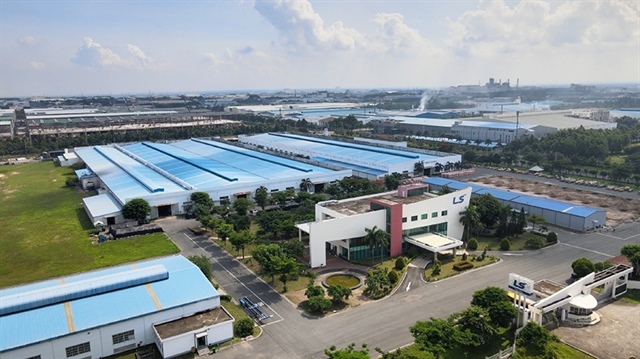Meat and dairy exporters up capacity to challenge rivals
Meat and dairy exporters up capacity to challenge rivals
With the meat and dairy sector in Vietnam suffering a trade deficit of $600 million last year, many exporters are now expanding performance to boost sales amid the country heading towards a rise in export of the products after the next few years.

Companies and authorities are working to increase Vietnam’s husbandry exports to reach a trade surplus
|
Statistics from the Department of Livestock Production (DLP) under the Ministry of Agriculture and Rural Development (MARD) showed that Vietnam reported an export turnover of $1.23 billion in meat and dairy products in 2020, while import turnover was $1.8 billion, signifying a trade deficit of $600 million. In the first quarter of this year, Vietnam spent $913 million importing meat and dairy, up 14 per cent on-year, meanwhile the export value of these goods was $89 million, up 35 per cent on-year.
Although there was a $824 million trade deficit in the first three months of this year, the shortfall is expected to narrow as the export turnover is forecast to continue rising this year amid the increasing global meat and dairy consumption. The United Nations Food and Agriculture Organization projects that global meat consumption will rise by over 1 per cent in 2021, with the fastest growth occurring in low- and middle-income countries, where incomes are climbing. Moreover, Vietnam’s meat and dairy sector hopes to raise its average production growth rate in 2021 by 5-6 per cent, according to the DLP. In the animal husbandry development strategy for 2021-2030, with a vision towards 2045, Vietnam also set the target to increase annual output.
Impressive growth
The export value of meat and dairy products in the first quarter has been continuing to maintain momentum. Poultry exports are mainly going to Asia, accounting for more than 99.9 per cent, of which, exports to Hong Kong accounted for 64.5 per cent, China for 8.8 per cent, and Thailand for 4.5 per cent.
Asia is also the largest export destination of dairy products, accounting for 94.6 per cent of total exports. Shelled eggs are mainly exported to Hong Kong (91.1 per cent), up 223.2 per cent on-year. Meanwhile, unshelled, boiled eggs were mainly exported to Singapore (56.8 per cent) and Japan (38.4 per cent).
In 2020, the export value of meat and dairy exceeded the $1 billion milestone for the first time. the export turnover climbed to $1.23 billion, double that of 2015. Meat production increased by 4.8 per cent on-year, with fresh milk and and buffalo meat ascending by 10.2 and 1.6 per cent, respectively. Key meat and dairy products of Vietnam (such as meat, egg, and dairy) are exported to 60 countries and territories.
The country’s fresh milk is exported to over 50 markets, accounting for 78 per cent of the export value. Meanwhile, chicken is exported to eight markets (16 per cent), pork to four countries with 5 per cent, and eggs to five markets with 1 per cent of the total export value.
Foreign-owned Koyu & Unitek Co., Ltd. specialised in poultry meat processing in the southern province of Dong Nai, has exported its first batch of chicken processed products to Hong Kong, making the economy its second export market after its previous success in Japan.
James Hieu Nhon Khuu, general director of Koyu & Unitek, told VIR, “Export is a potential channel given the local market facing fierce competition with imported products.”
At present, the company exports around 2,000 tonnes of chicken processed products per year to Japan, however the figure makes up only a fraction of the country’s demand. “Japan is the largest export market for meat and dairy in Asia, with its demand amounting to nine million tonnes of such products per year. Thus, there is a lot of room to expand,” Khuu said. “Compared to the domestic market, the sales prices overseas are 30 per cent higher, and that’s where our profit comes from. However, around 80 per cent of our products are currently still distributed domestically.”
The company plans to increase its processing capacity to 1,000 tonnes per month to serve its export plans in next few years.
Commenting on the potential export of the meat and dairy sector, Dam Van Hoat, director of Vietfarm Co. Ltd., said that Singapore and Hong Kong are the two large markets in Southeast Asia for the firm’s exporting salted duck eggs in Asia. Singapore alone consumes one million salted duck eggs per day, equivalent to 10 containers. However, Hoat’s company currently exports around two containers per month to this market.
Paving ways overseas
In a working session with the leaders of Son La People’s Committee in April, Vietnam-Australia joint venture Mavin Group expressed its interest in developing an export processing complex in the province. According to the plan, the complex will combine with an animal feed factory with an annual capacity of 450,000 tonnes, a poultry breeding system with 10,000 parent chickens and 20,000 parent ducks, and a pig system with 6,000 breeding sows and 150,000 porkers per year. The final component is an organic fertiliser factory running on livestock waste with an annual capacity of 15,000 tonnes. The project, which has a total investment capital of $26.1 million, is the first of its kind of Mavin Group so far. The project has received the thumb-up from the provincial authorities.
In mid-March, the Chinese General Administration of Customs granted transaction codes to two Vietnamese companies to export dairy products to China, according to the Ministry of Industry and Trade’s Asia-Africa Market Department.
The Netherlands’ FrieslandCampina Ha Nam Co., Ltd. can ship pasteurised and fermented milk to China, while FrieslandCampina Vietnam Co., Ltd. can export pasteurised and fermented milk, sweetened condensed milk, and other dairy products to the Chinese market.
To date, nine Vietnamese companies are granted such transaction codes from China, including TH Group, Hanoimilk, Bel Vietnam, Nutifood, and Vinamilk.
Last December, Thai-backed C.P. Vietnam exported the first batch of processed chicken to Hong Kong. Speaking at the inauguration ceremony of the CPV Food Binh Phuoc complex in Becamex Binh Phuoc Industrial Zone, the largest chicken breeding and processing project for exports in Southeast Asia, Montri Suwanposri, general director of C.P. Vietnam said, “With the initial investment capital of $250 million and an annual capacity of 100 million broilers after 2023, CPV Food Binh Phuoc will provide high-quality and safe chicken to domestic consumers and for export to Asia, Europe, and also the Middle East.”
Vu Manh Hung, general director of Hung Nhon JSC specialised in livestock production based in the southern province of Binh Phuoc, told VIR that the potential for exports of meat and dairy products is large, but much depends on each company’s production capacity, business strategy, and investments. “For example, Japan every year imports one million tonnes of poultry meat, but mostly from Brazil, Thailand, and China. In 2017, when Vietnam was preparing to export its first consignment of chicken to Japan, Thailand had just finished a prosperous year with 700,000 tonnes of exports to this and other markets. To be eligible for exporting products to Japan – one of the strictest export markets – the company has to make high investments,” he said.
According to MARD Deputy Minister Phung Duc Tien, the domestic meat and dairy sector’s current disadvantages include the small scale of vendors, and the underdeveloped links in production chains.
“While production, processing, and exports are all three important factors, enterprises have been mainly focusing on improving capacity. Moreover, the volume of exported meat and dairy products make up only a small portion of the more than $40 billion total export turnover of agricultural goods annually,” Tien said.

























